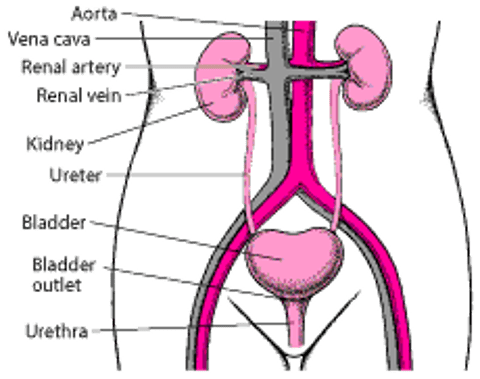Kidney Stones Symptoms, Treatment, and Prevention
By Glenn M. Preminger, MD, Duke Comprehensive Kidney Stone Center
Reviewed and Revised: January 2025
Synopsis
Kidney stones symptoms can be subtle or severe, often signaling a deeper urinary tract disorder. Kidney stones, also called urinary tract stones or calculi, are solid formations that develop in the kidneys, ureters, bladder, or urethra. These stones can cause pain, bleeding, infection, or block the normal flow of urine. Depending on their size and location, they may pass unnoticed or result in intense back or abdominal pain. Diagnosis usually involves imaging techniques like CT scans and urinalysis. Kidney stones treatment ranges from increasing fluid intake to minimally invasive surgical removal. Prevention often includes dietary and lifestyle modifications. The goal of this comprehensive guide is to help readers understand the underlying causes of kidney stones symptoms, how they manifest, and what steps can be taken to treat and prevent them effectively.
Table of Contents
- Understanding the Urinary System
- Prevalence and Demographics
- Complications of Urinary Tract Stones
- Types of Stones
- Causes and Risk Factors
- Kidney Stones Symptoms
- Diagnosis
- Kidney Stones Treatment Options
- Recovery and Aftercare
- Prevention Strategies
- Lifestyle Modifications and Long-Term Outlook
- Frequently Asked Questions
- Final Thoughts
- References
Understanding the Urinary System
The urinary system comprises the kidneys, ureters, bladder, and urethra. It plays a vital role in filtering waste products from the blood and expelling them through urine. Kidney stones symptoms often begin when stones obstruct any part of this system. Urine, which contains dissolved salts and minerals, may become oversaturated, causing crystals to form and harden into stones.
The kidneys filter about 50 gallons of blood every day, producing 1 to 2 quarts of urine. When urinary tract stones form and obstruct the system, it may lead to severe complications and pronounced kidney stones symptoms such as pain, nausea, and difficulty urinating. Proper functioning of the urinary system is essential for maintaining the body’s internal balance of water, electrolytes, and waste products.
Prevalence and Demographics
Kidney stones symptoms affect about 1–2% of adults annually in the U.S., leading to 1 in 1,000 adult hospital admissions. Incidence is increasing due to dietary and lifestyle changes. Men are more frequently affected, although the gap between genders is narrowing.
The recurrence rate is significant: 50% of people with one stone will develop another within 10 years. Kidney stones can range from small grains to large staghorn calculi that occupy the renal pelvis. Regional differences exist, with higher prevalence noted in warmer climates and in populations with higher rates of obesity and metabolic syndrome.
Complications of Urinary Tract Stones
Untreated urinary tract stones can lead to:
- Hydronephrosis (kidney swelling)
- Chronic kidney disease
- Recurrent infections (pyelonephritis)
- Sepsis
- Acute kidney failure
Infection-related stones, such as struvite, pose a high risk due to their association with recurrent urinary tract infections and persistent kidney stones symptoms. These complications not only impact quality of life but can also result in long-term damage to renal structures if not managed promptly.
Types of Stones
Urinary tract stones are categorized by composition:
- Calcium Stones (85%) – Mostly calcium oxalate or phosphate.
- Struvite Stones – Infection-related, composed of magnesium, ammonium, and phosphate.
- Uric Acid Stones – Form in acidic urine; linked to dehydration and high-protein diets.
- Cystine Stones – Rare, genetic disorder-related stones seen mostly in children.
Each stone type causes different kidney stones symptoms and requires tailored treatment. The chemical composition not only determines the choice of treatment but also influences the approach to long-term prevention.
Causes and Risk Factors
Factors contributing to kidney stone formation include:
- Low fluid intake
- High-sodium and high-protein diets
- Lack of citrate (natural inhibitor)
- Genetics
- Medical conditions like gout, diabetes, and inflammatory bowel disease
- Certain medications and supplements
- Post-surgical metabolic changes
Environmental factors such as climate, occupational dehydration, and certain lifestyle behaviors also increase risk. Understanding these risks can help in modifying behaviors that trigger kidney stones symptoms.
Kidney Stones Symptoms
Kidney stones symptoms depend on the size and location of the stone:
- Pain – Sharp, cramping pain in the back, sides, abdomen, or groin
- Hematuria – Blood in urine, visible or microscopic
- Urinary Symptoms – Burning, urgency, frequent urination
- Systemic Symptoms – Nausea, vomiting, fever, and chills (if infection is present)
Pain often comes in waves and may be among the most intense a person can experience. Kidney stones symptoms like fever require urgent care. Some stones may present without symptoms until they begin to move, making routine screening important in high-risk patients.
Diagnosis
Clinical Assessment
Doctors evaluate kidney stones symptoms to differentiate them from appendicitis, gallstones, pelvic diseases, or hernias.
Imaging
- CT Scan – Most accurate for detecting kidney stones
- Ultrasound – Preferred in pregnancy and pediatrics
- X-rays – Detect calcium-based stones
Lab Tests
- Urinalysis – Detects blood, crystals, infection
- Blood Tests – Assess kidney function
- Stone Analysis and 24-hour Urine Test – Identifies stone composition and risk factors
Proper diagnosis helps identify the underlying cause of kidney stones symptoms and informs treatment strategy.
Kidney Stones Treatment Options
Pain Relief
- NSAIDs and Opioids – Manage renal colic
Expulsion Therapy
- Alpha Blockers (Tamsulosin) – Facilitate stone passage
- Hydration – Important but should be monitored
Bypass and Surgical Methods
- Ureteral Stents and Nephrostomy Tubes – Maintain urine flow
- Shockwave Lithotripsy (SWL) – Breaks up stones non-invasively
- Ureteroscopy and Laser Lithotripsy – Endoscopic removal
- PCNL and Laparoscopy – For large or complex stones
Treatment decisions are based on stone size, location, symptoms, and patient health. Delayed treatment can worsen kidney stones symptoms and lead to complications.
Recovery and Aftercare
Post-treatment, monitor for recurrent kidney stones symptoms:
- Hydration
- Follow-up imaging
- Dietary adjustments
- Medication adherence
Recovery plans may include pain management, infection prevention, and long-term lifestyle counseling to reduce the chance of recurrence.
Prevention Strategies
General Tips
- Drink 2.5–3 liters of water/day
- Limit sodium and animal protein
- Eat calcium-rich foods (not supplements)
- Avoid oxalate-rich foods
For Specific Stones
- Calcium – Thiazides, potassium citrate
- Uric Acid – Alkalinization and allopurinol
- Cystine – Hydration, alkalinization, medications
- Struvite – Infection control, acetohydroxamic acid
Lifestyle Modifications and Long-Term Outlook
Long-term management of kidney stones symptoms involves permanent lifestyle changes. Adopting a plant-based diet, maintaining a healthy BMI, and reducing intake of processed foods can decrease recurrence risk. Patients should also manage comorbidities like hypertension and diabetes, which can exacerbate kidney conditions. Regular checkups, imaging, and urine testing play a role in ensuring stone-free status.
Frequently Asked Questions
Can kidney stones go away on their own?
Small stones (<5mm) often pass naturally with hydration and medication.
What foods should I avoid?
Foods high in oxalates (spinach, rhubarb), sodium, and animal protein.
Is recurrence common?
Yes. Up to 50% of patients develop another stone within 5–10 years.
Are kidney stones symptoms always painful?
Not always. Some stones are asymptomatic until they obstruct the urinary tract.
Final Thoughts
Kidney stones symptoms should never be ignored. They often indicate a serious underlying issue that requires diagnosis and kidney stones treatment. With modern interventions, most stones can be effectively treated. Preventive strategies remain essential to minimize recurrence. Consult healthcare providers to tailor a prevention plan suited to individual needs. Being proactive can prevent the onset of debilitating symptoms and ensure optimal urinary health.
References
- American Urological Association Guidelines
- National Kidney Foundation
- Mayo Clinic Kidney Stones Overview
- National Institute of Diabetes and Digestive and Kidney Diseases (NIDDK)
- MSD Manuals



